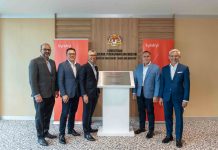
Singapore-headquartered Group-IB has revealed its findings about ARMattack, one of the shortest yet most successful campaigns by the Russian-speaking ransomware gang Conti. In slightly more than a month, the notorious ransomware collective compromised more than 40 companies worldwide.
The fastest attack took only three days according to Group-IB’s report “CONTI ARMADA: ARMATTACK CAMPAIGN”. In two years, the ransomware operators attacked more than 850 victims including corporations, government agencies, and even a whole country. The research dives deep into the history and major milestones of one of the most aggressive and organized ransomware operations.
Double hit
Group IB said Conti is considered one of the most successful ransomware groups. The gang’s existence first came to light in February 2020, when malicious files with the extension “.сonti” appeared on the radar of its researchers. However, the initial test versions of the malware date back to November 2019.
By the end of 2021, Conti came out on top as one of the largest and most aggressive groups, having published data belonging to 530 companies on its DLS. In just four months in 2022, the group posted information belonging to 156 companies, making for a total of 859 DLS victims in two years, including 46 in April 2022. The actual number of victims is believed to be significantly higher.
The cybersecurity firm noted that Conti and their affiliates attack often and quickly. Group-IB experts analysed one of the group’s lightning-fast and most productive campaigns, codenamed “ARMattack” which lasted only about a month (from 17 November to 20 December 2021), but it turned out to be extremely effective.
The attackers compromised more than 40 organizations worldwide. Most attacks were carried out in the US (37%), but the campaign also surged through Europe, with victims in Germany (3%), Switzerland (2%), the Netherlands, Spain, France, the Czech Republic, Sweden, and Denmark (1% each). The group also attacked organisations in the UAE (2%) and India (1%).
The top five industries most frequently targeted by Conti are manufacturing (14%), real estate (11.1%), logistics (8.2%), professional services (7.1%), and trade (5.5%). After gaining access to a company’s infrastructure, the threat actors exfiltrate specific documents (most often to determine what organization they are dealing with) and look for files containing passwords (both plaintext and encrypted).
Lastly, after acquiring all the necessary privileges and gaining access to all the devices they are interested in, the hackers deploy ransomware to all the devices and run it.
The geography of Conti’s attacks is vast but does not include Russia. The group clearly adheres to the unspoken rule among Russian-speaking cybercriminals: do not attack Russian companies, Group-IB said.
Well organised
Just like a legitimate IT business, the hacker has its own HR, R&D, and OSINT departments. There are team leads, regular salary payments, and an incentive program. One of its distinctive features is using new vulnerabilities, which helps the group gain initial access.
For instance, Conti was seen exploiting the recent CVE-2021-44228, CVE-2021-45046 and CVE-2021-45105 vulnerabilities in the log4j module. Less than a week later, Conti exploited these vulnerabilities to attack vCenter servers. The leaked chat logs also showed that the group monitors fresh vulnerabilities carefully.
“Conti’s increased activity and the data leak suggest that ransomware is no longer a game between average malware developers, but an illicit RaaS industry that gives jobs to hundreds of cybercriminals worldwide with various specializations,” said Ivan Pisarev, Head of Dynamic Malware Analysis Team at Group-IB’s Threat Intelligence department.
“In this industry, Conti is a notorious player that has in fact created an ‘IT company’ whose goal is to extort large sums. It is difficult to predict what will happen to Conti in the future: whether it will continue working after a large-scale rebranding or be divided into smaller sub-projects. It is clear, however, that the group will continue its operations, either on its own or with the help of its “subsidiary” projects.”














